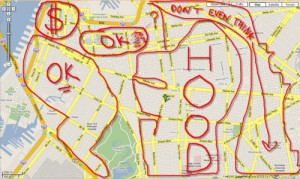“The Art of Peer Pressure” is the track that proceeds “Backseat Freestyle.” In our discussion of “Backseat Freestyle,” it was stated that Lamar used macho and phallic language to assert his bravado. The selfishness of “Backseat Freestyle” is juxtaposed with the selflessness of “The Art of Peer Pressure.” This track is the first on “Good Kid, m.A.A.d City” where Lamar gives a story about his experiences in Compton. “The Art of Peer Pressure,” according to Lamar, was meant “to take people on that ride, on that journey. It’s about being a teenager from L.A. and being influenced by your peers and who you’re hanging out with.” Lamar tries to assert his individuality with “Backseat Freestyle” but is contrasted with “The Art of Peer Pressure” which describes Lamar’s tendency to act violently or out of character because of his peers.

In Compton, there is a tension for individuals to assert their individuality while maintaining a certain group identity. Individuals are swayed between this tension and challenged to act with their peers while also defining themselves from their peers. Lamar finds it difficult to remain true to himself because of peer pressure, recognizing that their actions have altered his personality: “…I’ve never been violent, until I’m with the homies.” Thus explains Lamar participating in a home robbery conducted by his peers. Lamar is aware of his personal qualities and morals but because of his group affiliation acts uncharacteristically, knowing that his actions are wrong. The juxtaposition between “Backseat Freestyle” and “The Art of Peer Pressure” reveals this tension and illustrates Lamar as consciously aware of his moral depravity at the result of his peers.
20th century American racism transpired into multiple institutions. For example, in the 1930s and 1940s the Home Owner Loan Corporation (HOLC) and the Federal Housing Authority (FHA), which was developed to protect and check homeownership, a significant part of the nation’s wealth, discriminated against minorities. The HOLC and FHA were the institutions responsible for approving and distributing loans. In the 1930s and 1940s, several communities that were made up of minorities were “redlined” and were labeled “unsafe” to live in. As a result, this made it very difficult for minorities to receive loans for their homes and dissuaded outside individuals to move and economically develop that region. Moreover, most of these locations were in urban regions. Thus, these practices caused a demographic shift in the middle of the 20th century, leaving several minorities in urban locales and caused whites to move into suburbia.

These geographic and demographic shifts comparmentalized minorities into urban regions. As a result these locations which were typically economically deprived developed an “us vs. them” mentality among its residents. Lamar’s ideas on “The Art of Peer Pressure” contradict Stiff Little Fingers’ “Here we Are Nowhere” which champions a group mentality surrounded around punk music. The hopelessness associated with these new spaces caused several in America to join together and act with a group mentality to challenge and become more mobile within these confining spaces. Hence, came the gang culture that developed in Los Angeles, New York City, Chicago, and Lamar’s home of Compton. The gang, group mentality resorted to violence and crimes to address the wrongs that were deprived of them because of their geography. Lamar’s “The Art of Peer Pressure” unconsciously reveals this history and displays an individual who, consequently, is alienated by this gang mentality.
[If you would like to refresh your interactive experience please pinback to the songs.]